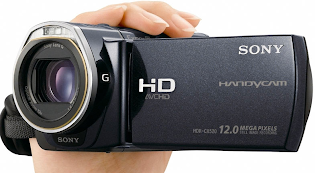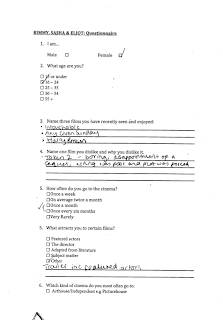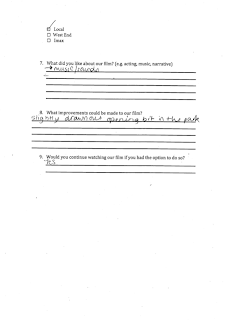Georgina Media
Monday, 17 June 2013
Saturday, 4 May 2013
Wednesday, 17 April 2013
Thursday, 7 March 2013
Evaluation Question 7
7. Looking back at your preliminary task, what do you feel you have learnt in the progression from it to the final product?
The contrast between filming
the preliminary task to shooting our coursework opening has been vast. We faced
many differences between a short, 30-second piece and a much more demanding
2-minute opening, which required extensive refinement in comparison to the
roughness of the preliminary task, and I feel I have learnt a lot in the
process of overcoming these obstacles.
Firstly, the planning and
preparation was much more demanding for the opening task than what I needed for
the preliminary. I developed my skills in creating shot lists and storyboards,
giving the opening much more structure and development before shooting that the
preliminary ever had. Because of these planning techniques, when it came to
shooting I had a much clearer idea of the shots needed and angles required to
complete a certain sequence, and whilst editing I could refer to the storyboard
for guidance. For example whilst shooting the dream sequence of the opening I
filmed many shots we had not thought of in the planning stages, however during
editing I learnt how useful the storyboard was in helping me effectively use
these shots without loosing the narrative of the opening.
Logistically, I learnt a lot
in the difference of shooting on sight in the school for the preliminary to
filming on different locations around London. The group and I had to continuously
over think in our preparations for days of shooting, especially when preparing
the equipment, whereas for the preliminary all out equipment was on sight and
easily accessibly. These concerns combined with additional actors created some
tense moments during shooting, however we quickly learnt to thoroughly ensure
the equipment was correct and therefore filming became a lot smoother and
effective.
My use and knowledge of the
equipment also progressed in the time between the preliminary task and the
opening task. For the preliminary, I simply used one camera with no extras
equipment. However in the opening task, I used multiply lights, microphones and
a micro track simultaneously to achieve the desired effect. This required a
drastic increase in knowledge and capability with the equipment than I needed
for the preliminary; therefore I quickly progressed in order to utilize all
these benefits.
The area I progressed most in
was during the film editing. For the preliminary, my editing skills were
noticeably amateur and choppy, resulting in a jittery piece that did not run
smoothly and was extremely simple. In order to make the opening task seem more
professional and run generally smoother, I learnt a great deal about using
final cut pro and quickly developed my editing skills. This resulted in a much
smoother, sharper piece, with equalized sound, subtle effects and the
incorporation of graphics. My continuity editing also improved, with techniques
such as match on action, sound bridges and fades all being used to improve the
opening task.
Overall, I fell I have learnt
a lot in my progression from the preliminary to the opening task, in all
aspects of filming. I feel I have especially learnt the benefits of thorough preparation
in the planning stages, which I have seen have a great effecting in both the
shooting stage and finally the editing, leading to the smooth creation of the
opening task.
Wednesday, 6 March 2013
Evaluation Question 6
6. What have you learnt about technologies from the process of constructing this film opening?
From the practise in the preliminary task, we already knew how to roughly use the camera and tripod. However, when trying to produce a slicker film, we encountered some problems with the equipment. For example when attempting to pan or track the camera, we realised we could not get a smooth shot as we always discovered a shaky effect when reviewing the footage. After regrouping, we managed to cut and reshoot some shots in order to give our film a smoother look.
 We also tried to use a variety of lights to intensify out shots. However when using them we realised that they were too unnatural to use and we also struggled with coordinating them with the power packs, therefore most of the time they ran out of battery on set.
We also tried to use a variety of lights to intensify out shots. However when using them we realised that they were too unnatural to use and we also struggled with coordinating them with the power packs, therefore most of the time they ran out of battery on set.
Generally, using the filming technology such as the camera and lights proved fairly challenging, as no one in our group was specifically talented at understanding the different technologies. However once we read every single on the equipment before shooting, we learnt how to effectively use the equipment to the best of our ability.
As we had all used macs before, and one member of our group was doing a computing AS level, using that technology was not difficult. However none of us had used final cut pro before to edit our film, other than a brief rough cut of our preliminary, in which we barely had to know about the software. When editing the final piece, we learnt how to use various tools and effects in editing, such as using filters, slowing down footage, inserting titles and overlaying music. This proved the most challenging of all the technologies, as whilst editing the final cut pro would regularly shut down, though our work was saved. Finally we managed to use final cut pro and the majority of its tools to produce our final piece, overcoming our issues with the technology.
From the practise in the preliminary task, we already knew how to roughly use the camera and tripod. However, when trying to produce a slicker film, we encountered some problems with the equipment. For example when attempting to pan or track the camera, we realised we could not get a smooth shot as we always discovered a shaky effect when reviewing the footage. After regrouping, we managed to cut and reshoot some shots in order to give our film a smoother look.
 We also tried to use a variety of lights to intensify out shots. However when using them we realised that they were too unnatural to use and we also struggled with coordinating them with the power packs, therefore most of the time they ran out of battery on set.
We also tried to use a variety of lights to intensify out shots. However when using them we realised that they were too unnatural to use and we also struggled with coordinating them with the power packs, therefore most of the time they ran out of battery on set.Generally, using the filming technology such as the camera and lights proved fairly challenging, as no one in our group was specifically talented at understanding the different technologies. However once we read every single on the equipment before shooting, we learnt how to effectively use the equipment to the best of our ability.
As we had all used macs before, and one member of our group was doing a computing AS level, using that technology was not difficult. However none of us had used final cut pro before to edit our film, other than a brief rough cut of our preliminary, in which we barely had to know about the software. When editing the final piece, we learnt how to use various tools and effects in editing, such as using filters, slowing down footage, inserting titles and overlaying music. This proved the most challenging of all the technologies, as whilst editing the final cut pro would regularly shut down, though our work was saved. Finally we managed to use final cut pro and the majority of its tools to produce our final piece, overcoming our issues with the technology.
Tuesday, 5 March 2013
Monday, 4 March 2013
Evaluation Question 4
4. Who would be the audience for your film?
Due to the mature themes in our
film, such as the drug use and perhaps violence after the opening, we would
expect a certification of 15 for our film. A 15 certificate would cover our
film, allowing drug use, frequent strong language and strong violence
throughout the duration of the film. The BBFC describes the guidelines for the
portrayal of dangerous behavior in films as that ’’dangerous behavior such as … suicide … should not dwell on
detail that could be copied’’. As we would most likely have scenes
such as this in our film, and already in the opening drug use is mentioned, we
could not qualify for a 12 or 12A rating as drug use must be ’’infrequent’’ and scenes of violence must be ’’moderate’’ and should not put ’’emphasis on injuries or blood’’. Therefore, our audience must be
from the age 15 and up, as it would be inaccessible and inappropriate for a
younger audience.
This is what we expected, and knew that
our target audience would be in the category of 15-24 years. This is the most
popular category for attending the cinema, and we felt the subject matter,
themes and characters would be easily accessible for those in their teenage
years, whilst also ensuring maximum profits for the film.
 Another insight to our target audience
was comparing it to other, similar films such as Black Swan and Girl,
Interrupted. These films shared similar themes with ours, and therefore we
would most likely attract the same type of audience. The two comparable films
attracted mainly a female audience, with Girl, Interrupted attracting a younger
audience of 18-30 yrs whilst Black Swan more likely attracting a slightly older
audience due to director Aronofsky credits bringing in older generations. With
this information, and comparing both films to ours, it is reasonable to suggest
that the audience for our film would be predominantly female, with a younger
age target as it is classified under both films as a 15.
Another insight to our target audience
was comparing it to other, similar films such as Black Swan and Girl,
Interrupted. These films shared similar themes with ours, and therefore we
would most likely attract the same type of audience. The two comparable films
attracted mainly a female audience, with Girl, Interrupted attracting a younger
audience of 18-30 yrs whilst Black Swan more likely attracting a slightly older
audience due to director Aronofsky credits bringing in older generations. With
this information, and comparing both films to ours, it is reasonable to suggest
that the audience for our film would be predominantly female, with a younger
age target as it is classified under both films as a 15.
We also used a survey to assess our target audience. The majority of the surveyed were female, with 4 males attending. From this we learnt that our target audience was exclusively in the 16-24 age category, with their cinema attendance usually from once a month. We also saw that their main attraction to films was through featured actors, followed by either the director or subject matter attracting them to a film. All the surveyed also said they would continue watching our film after viewing the opening two minutes.
In conclusion it is fair to say that our target audience for our film would be those 15-24 years old, with a mainly female demographic. However seeing as we did not survey anyone above the age of 16 due to complications, we cannot certainly say what our audience would have been if older people had taken part in the survey.
Subscribe to:
Comments (Atom)

